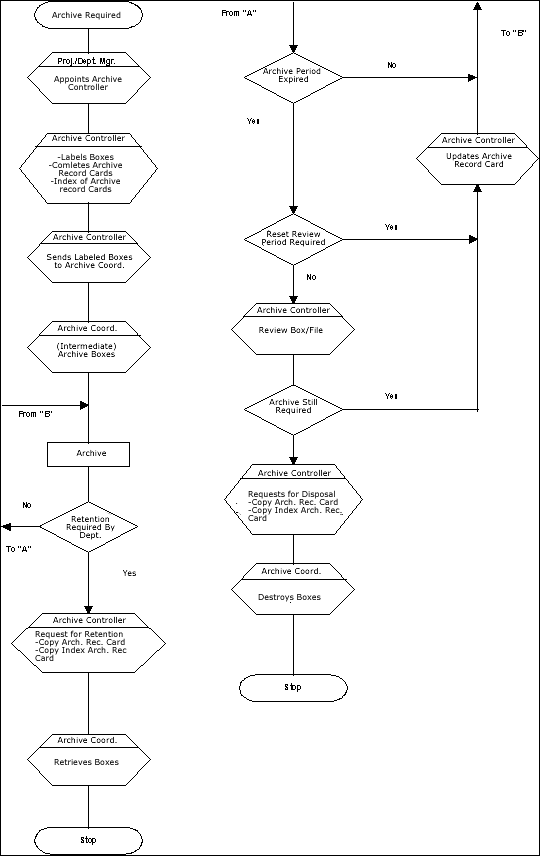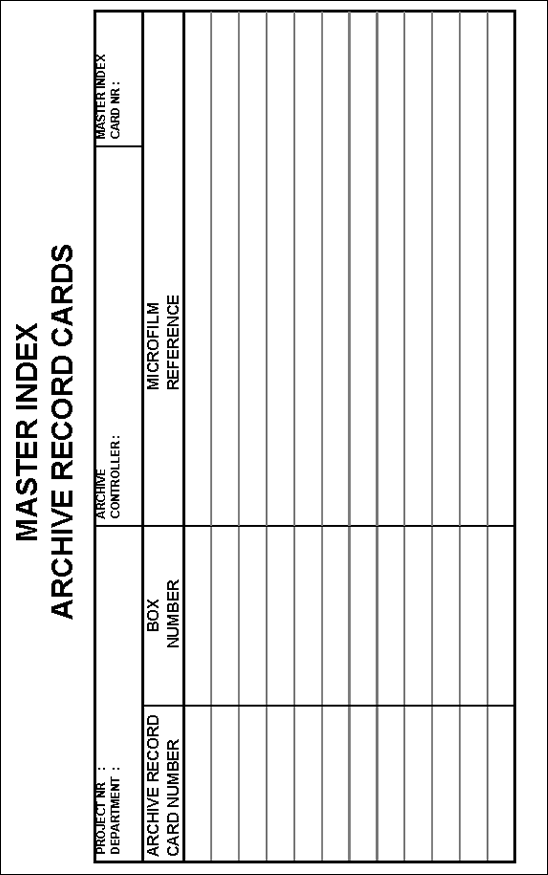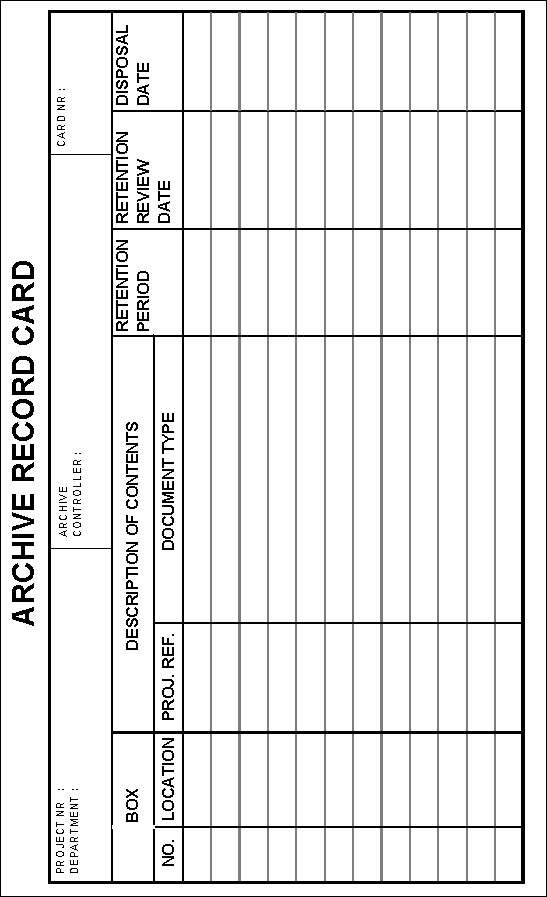Table of Contents
1. Purpose
This procedure covers the archiving of documents as defined in procedure, ref. 6.1.
2. General
At the end of the project all documents that have not already been microfilmed or destroyed shall be archived or stored in accordance with this procedure.
The originals should be kept for further retention as laid down in the procedure, ref. 6.1. Comprehensive indexes of all retained hard copy documentation must be prepared.
3. Responsibilities
The Archive Coordinator is responsible for the acceptance, removal and disposal of the boxes from the archive.
The Department Managers or the Project Managers are responsible for assigning an Archive Controller.
The Archive Controller is responsible for labelling the boxes for the archive and maintaining the department archive record card (index). He shall also indicate the retention/removal of documents from the archive.
4. Procedure
At the start of a project the Project Manager is responsible to determine the legal and the project requirements regarding the period of retention and the type of copy to be retained (ref. also 6.1).
The Department Managers are responsible to determine the departmental needs regarding the period of retention and the type of copy to be retained.
The Project Manager or the Department Manager shall assign an Archive Controller.
4.1 Storage
4.1.1 Magnetic Storage
With the increasing use in the industry of computing and word processing, magnetic storage devices are used for projects as an alternative to hard copy. Many files may exist solely as a magnetic disk, diskette, or magnetic tape, hard copies being produced from them could only reflect a part of the data stored. Such files are economic in that they can hold large quantities of data.
Generally, magnetic filing media shall be stored within a stable environment, away from areas of high electrical and magnetic activity that could cause corruption of the data.
They shall be kept within their protective containers until loaded into the operating devices; this is particularly relevant in the case of disks. Though more durable and less "sensitive", word processing diskettes should not be left lying on desk tops after usage. All containers should be locked away at night or when not in use. Indices of the disks shall be maintained for easy retrievability.
If disks contain data of an important nature, then copies shall be made for storage in a location remote from where the original is kept. Diskette copies of important data should also be a feature of word processing installations.
Disks shall not be sent to the archive.
4.1.2 Storage of Microfilms
All project microfilms, as defined per procedure (ref. 6.1), are to be located in a security room located in the Intermediate Archive Storage (see section 4.2.2).
All departmental microfilms, as defined per procedure (ref. 6.2), are also to be located in a security room located in the Intermediate Archive Storage (see section 4.2.2).
Microfilms designed for archive storage should first be checked for authenticity, legibility and completeness, and if approved should be stored in suitable containers, i.e. cassettes/boxes in which the film was originally supplied, or proprietary microfilm storage boxes. Each microfilm should also have an identifying index as one (or more) of the first frames of the film.
Consignments of microfilm put into the archive stores are to be enclosed in the standard store-drawer filing cabinets.
The Archive Controller shall enter details of the films stored on an archive record card see below figure) and the archive record card master index (see below figure).
4.1.3 Storage of Tapes and Disks
The storage of tapes and disks is defined in ref. 6.3, section 4.5.
4.2 Archiving
4.2.1 Method of Storage
Two levels of archiving exist:
-
Intermediate Archive Storage
-
Archive Storage
The method of storing data for either Intermediate Archive Storage or Archive Storage will be common to both. All recorded documentation will be packed into standard store-drawer filing cases. Packing, labeling and registering are the responsibility of the department concerned. The Archive Controller is responsible for ensuring that the master index (see below figure), the archive record cards (see below figure) and the archive box labels (see below figure) are completed correctly with the appropriate information.
The Archive Controller maintains a file of his archive record cards and master index.
The Archive Controller shall ensure that a full set of photocopies of each archive record card for which he is responsible is included in the department master index of their archive records.
The Archive Controller must apply in writing to the Archive Coordinator for acceptance and removal of archive boxes to the appropriate storage and shall send with the request a complete set of copies of the archive record cards for retention and reference by the Archive Coordinator. He shall also include a set of copies in the project department master index.
Storage boxes will not be accepted if they are not labelled and the label completed correctly. Boxes are not to be labeled "Civil/Structural" - "Intermediate Storage" or "VCM" or any similar enigmatic statement.
The transfer to, and location of, the filing boxes in the storage areas is the responsibility of the Archive Coordinator.
If the hard copy has to be retained in the working area, it shall be stored in appropriate plan cabinets or on shelves in that working area, indexed clearly and logically and marked with the review date.
4.2.2 Intermediate
Intermediate archive storage exists as an intermediate state between current files housed in (or adjacent to) a department/workstation, and the archive storage housed remote from the main offices.
Company will keep a copy or preferably the original of all correspondence, major documents specifications, calculations and drawings in an intermediate archive storage for a period of six months after a project is accepted by the Client, i.e. from issue of a "Final Acceptance" certificate (ref. 6.1, attachment 1, entry points "X.5" and "X.G").
Its purpose is to store documentation or reference material which no longer needs to be constantly on hand. As infrequent reference may be necessary to the files stored, they must be reasonably accessible and recovery possible within a reasonable period. At present the intermediate archive storage area is located in the basement of the Company building
Space in the intermediate archive store is limited, so therefore a critical process of selection must be undertaken prior to sending files for such storage. The criteria for selection should follow the final disposition list, which is attachment 1 of procedure (ref. 6.1).
The departments responsible for the collection and retention of the respective project documents on behalf of the Project Manager are indicated on above list.
It is expected that archiving according to the list will minimize the duplication of documents put to archives.
It is envisaged that the transfer of files from the working area to archive will entail a period in the intermediate archive storage.
4.2.3 Archive Storage
This storage area will be at a location remote from the Company building and is intended for documents or reference material which, after their active life is over, need to be retained.
4.3 Retention Review - File Destruction
Review of box/file contents according to the review periods set at the time of archiving, is the responsibility of the Archive Controller. Review periods will be re-set or a decision taken to scrap originals or contents and the archive record cards amended accordingly.
Once advised by the responsible person of a decision to scrap and given clear details in writing for correct identification, the Archive Coordinator will arrange with Administration Services for the incineration of the unwanted material. Should there be any doubts as to correct identification, departments must be prepared to send a representative to the archive to identify the files concerned.
5. Flowchart

6. References
|
Document Number |
Title |
Level |
|
| 6.1 |
CM-PE-111 |
The Final Disposition of Project Documentation |
2 |
| 6.2 |
CM-MA-109 |
Microfilming of Department Documents |
2 |
| 6.3 |
CM-CA-001 |
Utilization of Information Processing Systems |
2 |
7. Attachments
-
Archive Box Label
-
Archive Record Card
-
Master Index - Archive Record Cards
Archive Box Label
|
ARCHIVE BOX LABEL |
|
|
Project NR.: Department: |
|
|
Box Number: |
Location: |
|
Disposal Date: |
|
|
Remarks: |
|
Archive Record Card

Master Index - Archive Record Cards


